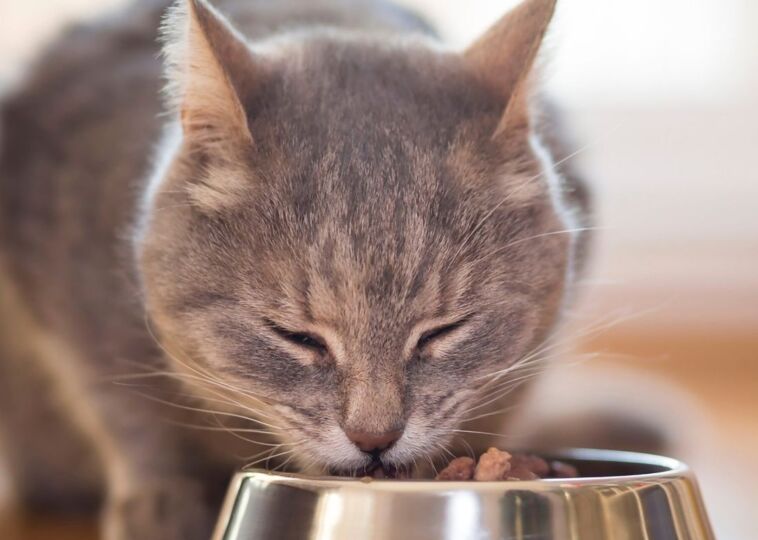These 9 Surprising Foods are Hurting Your Cat! Learn What to Avoid

Contents [hide]
Cats are more than just pets; and they’re family. And as with any family member, we want to ensure they’re healthy, happy, and thriving. One of the most important aspects of caring for your feline friend is their diet.
But did you know that some foods you might think are harmless or beneficial could actually be doing more harm than good? It’s easy to assume that what’s safe for us is safe for our pets. Cats have unique dietary needs; certain foods can be toxic or cause serious health issues.
It’s easy to slip into the habit of sharing our meals with our feline companions, but their bodies aren’t built to handle the same diet. By avoiding these dangerous foods and sticking to a balanced diet specifically formulated for cats, you’ll be taking a significant step in ensuring your beloved pet lives a long, healthy, and happy life.
Raw Potato

Potatoes are a staple in many kitchens, making it easy to overlook their potential danger to our pets. While they’re a versatile and nutritious human vegetable, the same doesn’t hold for our feline friends. Cats are curious creatures and often explore their environment through taste.
If you’re preparing a meal and a piece of raw potato falls to the floor, your cat might be tempted to give it a nibble. The main issue with raw potatoes lies in a chemical compound called solanine. Found primarily in the leaves, stems, and skin of potatoes, especially green or sprouting ones, solanine is toxic to cats.
While cooked potatoes aren’t as dangerous as their raw counterparts, they still don’t give cats any real nutritional benefit. Unlike humans, cats are obligate carnivores, meaning they thrive on a diet rich in animal proteins. While small, cooked potato pieces might not be immediately harmful, they can contribute to an unbalanced diet if fed regularly.
Onion and Garlic

Onion and garlic are common ingredients in many of our favorite dishes, but they’re anything but safe for your cat. Onions and garlic belong to the Allium family, including leeks, chives, and shallots. While these might be delicious additions to our meals, they contain toxic compounds to cats.
The primary culprits are thiosulfates, which can damage your cat’s red blood cells. Even a bit of onion or garlic can cause immediate health issues in your cat. The real danger of onion and garlic comes with repeated exposure or larger doses.
Over time, the damage to red blood cells can lead to hemolytic anemia, where the body destroys its red blood cells faster than it can produce. Anemia is severe and can cause symptoms like pale gums, rapid breathing, and collapse. Even a tiny piece of onion or a garlic clove can trigger symptoms.
Regularly feeding your cat table scraps that contain these ingredients or unknowingly offering them food flavored with onion or garlic powder can gradually lead to severe health issues. The best way to protect your cat is simple: keep onion and garlic out of their diet entirely.
Raw Egg

Eggs are often hailed as a superfood, packed with high-quality protein, essential vitamins, and healthy fats. They might seem like the perfect treat for your cat, but The most concerning are Salmonella and E. Ingesting raw eggs can lead to food poisoning, causing symptoms such as vomiting, diarrhea, and lethargy.
Beyond bacteria, there’s another, less apparent reason raw eggs are bad news for cats: avidin protein. Found in egg whites, avidin binds to biotin, an essential B vitamin, and prevents your cat’s body from absorbing it. Biotin is crucial in maintaining healthy skin, fur, and metabolism.
When your cat’s biotin levels drop, it can lead to various health issues, including skin irritations, hair loss, and growth problems. Once cooked, eggs can be a nutritious addition to your cat’s diet in moderation, providing them with a healthy dose of protein and other essential nutrients without the risk of bacterial infection or biotin deficiency.
Feeding raw eggs to your cat might seem like a natural choice, especially if you’re trying to mimic a more ‘natural’ diet. While cats in the wild might encounter raw eggs occasionally, they also face the natural consequences, which can include illness and even death.
Raw Meat and Fish

It’s tempting to think that feeding your cat raw meat or fish is just a nod to their wild ancestors, giving them a more natural diet. But feeding your cat raw meat or fish can open the door to severe health issues that could have been easily avoided.
First, raw meat and fish are notorious for harboring harmful bacteria like Salmonella and E. These pathogens can cause severe food poisoning, vomiting, diarrhea, and lethargy. While your cat might seem harsh, their immune system isn’t invincible, and these bacteria can wreak havoc on their health. But bacteria isn’t the only concern.
Raw fish, in particular, contains an enzyme called thiaminase, which destroys thiamine, an essential B vitamin. It’s simple: cook the meat or fish before serving it to your cat. Cooking effectively eliminates the dangerous bacteria that could make your cat sick and neutralizes the harmful enzymes in fish.
You might have heard about raw diets for cats becoming more popular, with claims that they’re closer to what cats would eat in the wild. While this might sound appealing, it’s important to remember that wild doesn’t always mean safe or healthy. In the wild, cats face many risks that domesticated cats don’t, including exposure to diseases and parasites.
Chocolate

Chocolate might be a sweet treat, but it’s anything but for your cat. While we often associate chocolate with indulgence and health benefits, the story is quite different for our feline friends. Chocolate is one of the most dangerous foods you can give your cat.
Chocolate contains two essential compounds particularly toxic to cats: theobromine and caffeine. While humans can metabolize theobromine relatively quickly, cats process it more slowly. This slow metabolism allows theobromine to build up to toxic levels in a cat’s system, leading to a range of severe health issues.
Even a small amount of chocolate can cause symptoms like vomiting, diarrhea, and restlessness. Caffeine works similarly to theobromine but is even more potent in small doses. Caffeine is a common ingredient in many types of chocolate, incredibly dark chocolate, which poses an even greater risk to cats.
Just like theobromine, caffeine can cause a spike in heart rate, nervousness, and tremors, making it a dangerous addition to your cat’s diet. You might wonder how much chocolate it would take to harm your cat.
Dairy Products

It’s an image we all know: the contented cat lapping up a bowl of milk. But here’s the truth: dairy products might not be as harmless as they seem. Like some humans, cats lose the ability to digest lactose properly, the sugar found in milk, as they grow out of kittenhood.
While kittens can digest their mother’s milk thanks to the enzyme lactase, most adult cats lose this ability as they age. This means that when an adult cat consumes dairy products, their digestive system struggles to process the lactose, leading to uncomfortable and potentially harmful side effects.
When a cat consumes dairy, especially in large amounts, the lactose passes through their digestive system without being properly broken down. Small quantities of occasional dairy might not cause immediate harm, but regular consumption can lead to more severe health issues.
Additionally, suppose your cat regularly consumes high-fat dairy products like cheese. In that case, they’re at risk of developing obesity, which can lead to a host of other health complications, including diabetes and heart disease. While it eliminates the lactose problem, it’s important to remember that cats don’t need milk in their diet at all.
Tuna

It’s no secret that cats love fish, and if there’s one fish that seems to capture their hearts and taste buds, it’s tuna. The image of a cat eagerly lapping a tuna bowl is almost iconic.
But as much as your feline friend might love this fishy treat, it’s essential to know that too much tuna can harm their health. First, Tuna has a strong, rich aroma and flavor that is irresistible to many cats. It’s also packed with protein, a vital component of a cat’s diet.
However, just because they love it doesn’t mean it’s the best thing for them. Tuna is rich in unsaturated fats. While fats are essential to a balanced diet, too much of a good thing can be harmful, especially for cats.
High levels of unsaturated fats can lead to a condition known as steatite, or yellow fat disease, which causes painful inflammation of the fatty tissue. Tuna, especially certain types like albacore, contains higher mercury levels than other fish. Mercury poisoning is a serious risk if your cat consumes too much tuna over time.
Alcohol

You might think of alcohol as something that’s strictly off-limits for pets, but many people don’t realize just how harmful it can be. Even the smallest amount of alcohol can have devastating effects on a cat’s body, and the consequences are far more severe than you might expect. Cats are much smaller and metabolize substances very differently than humans.
Alcohol, which might take several drinks to affect a human, can start causing problems in a cat after just a few sips or even less. What makes alcohol so dangerous is its ability to depress the central nervous system, leading to a cascade of potentially lethal symptoms.
In cats, alcohol acts as a potent depressant, slowing down brain activity and bodily functions. Spilled drinks, unattended glasses, or even alcohol-infused foods can be enough to expose your cat to dangerous levels of alcohol. Cats are naturally curious; if they find a way to lick up alcohol, the results can be disastrous.
The best way to protect your cat from the dangers of alcohol is by prevention. Never leave alcoholic beverages unattended, and be cautious with any food that contains alcohol. Ensure your cat’s environment is safe, and if there’s ever an accident where your cat ingests alcohol, contact your vet immediately.
Dog Food

If you’re a multi-pet household, you might be tempted to simplify feeding by sharing one type of food for your dog and cat. It’s a common question among pet owners: Can dogs and cats eat the same food? Cats and dogs have distinct dietary requirements shaped by their evolutionary paths and biological needs.
Cats are obligate carnivores, meaning their bodies are designed to get most of their nutrients from meat. On the other hand, dogs are more omnivorous and can thrive on a diet that includes animal and plant protein sources.
Feeding your cat or dog food, which might have lower protein levels, can lead to nutrient deficiencies and health issues over time. Cats and dogs also have different vitamin needs. For example, cats need higher amounts of vitamin A, which they get directly from animal tissues, whereas dogs can convert beta-carotene from plant sources into vitamin A.
Dog food might not contain enough vitamin A to meet a cat’s needs, leading to deficiencies and related health problems. Essential fatty acids are another area where cats and dogs differ. Cats need more arachidonic acid, a type of fatty acid found in animal fat, which is vital for their skin health and overall well-being.


